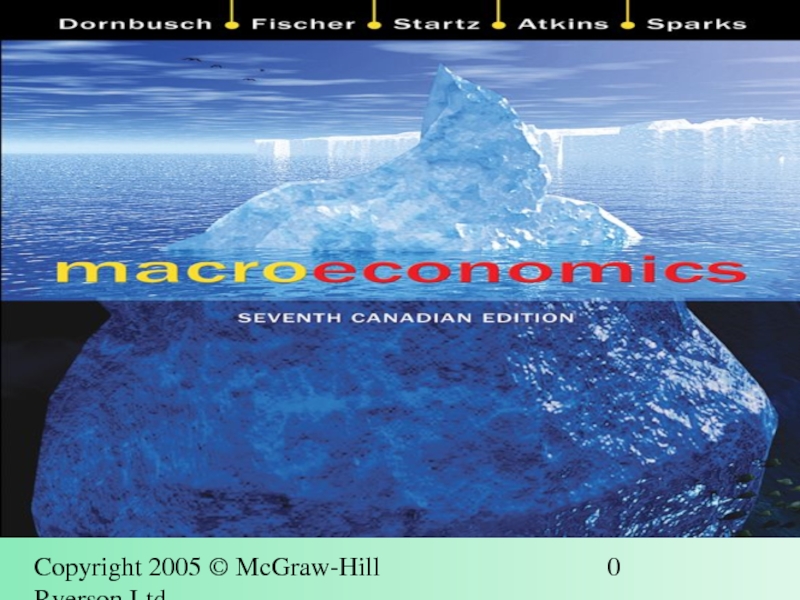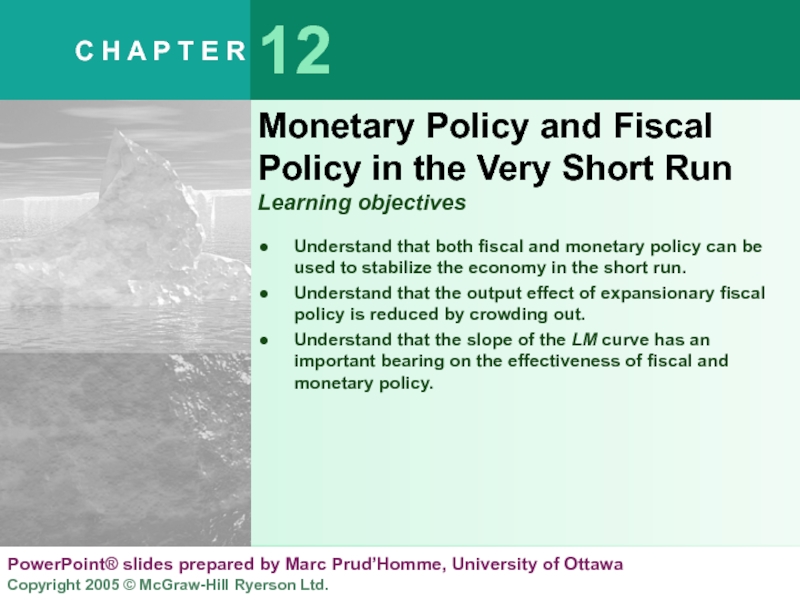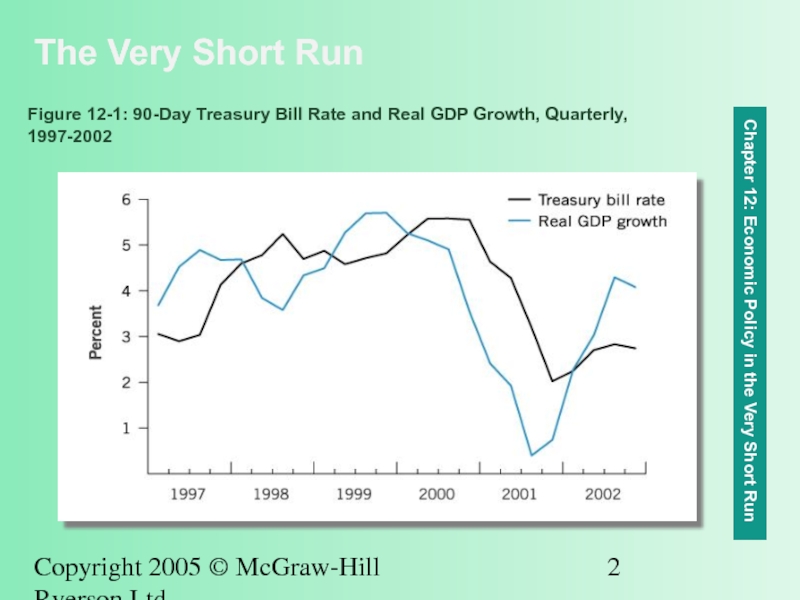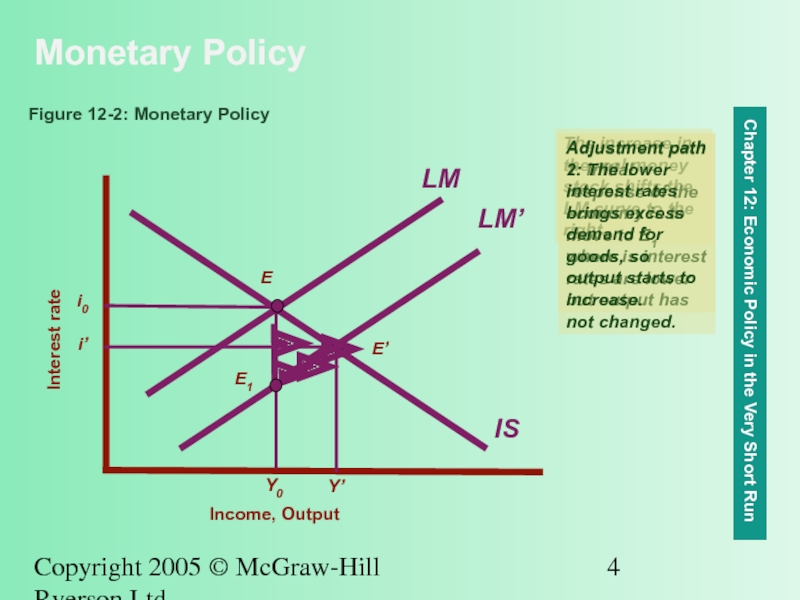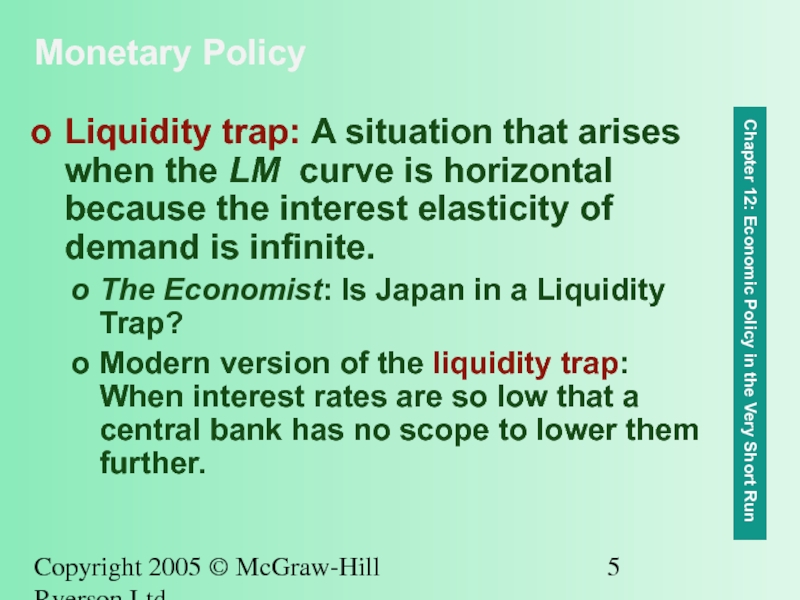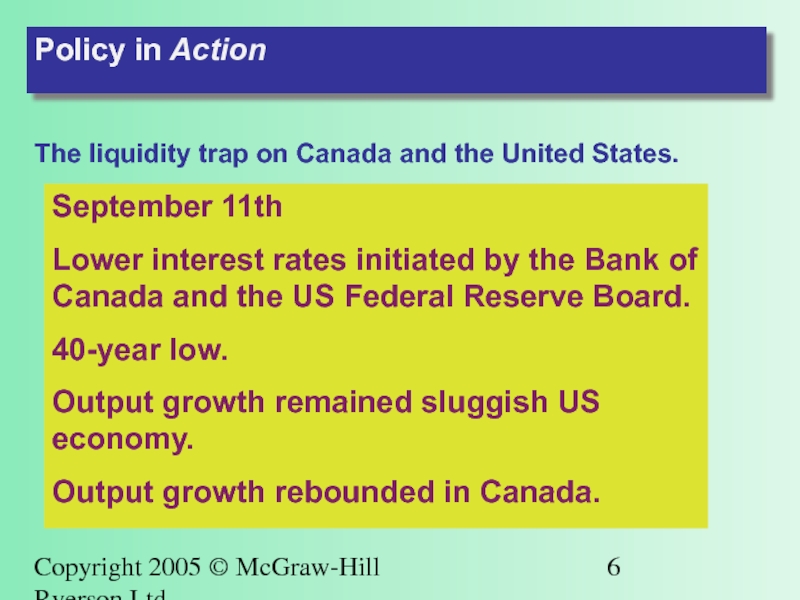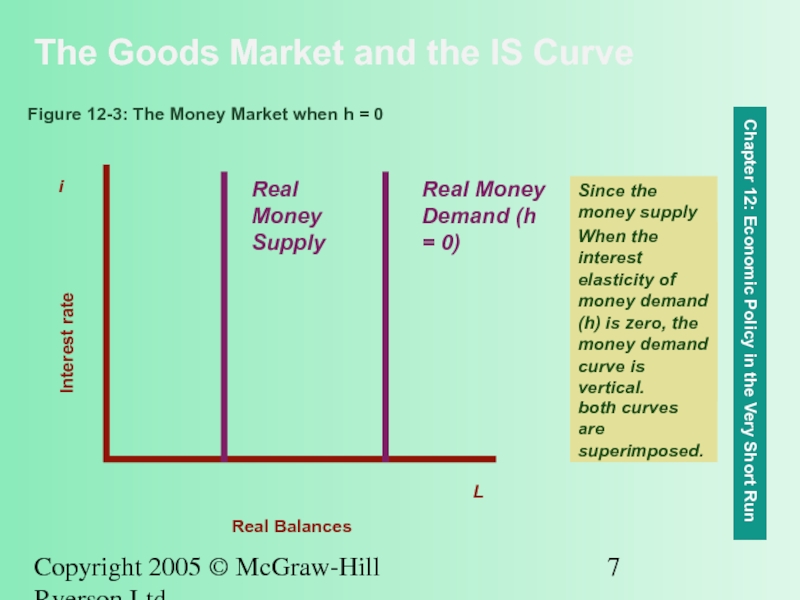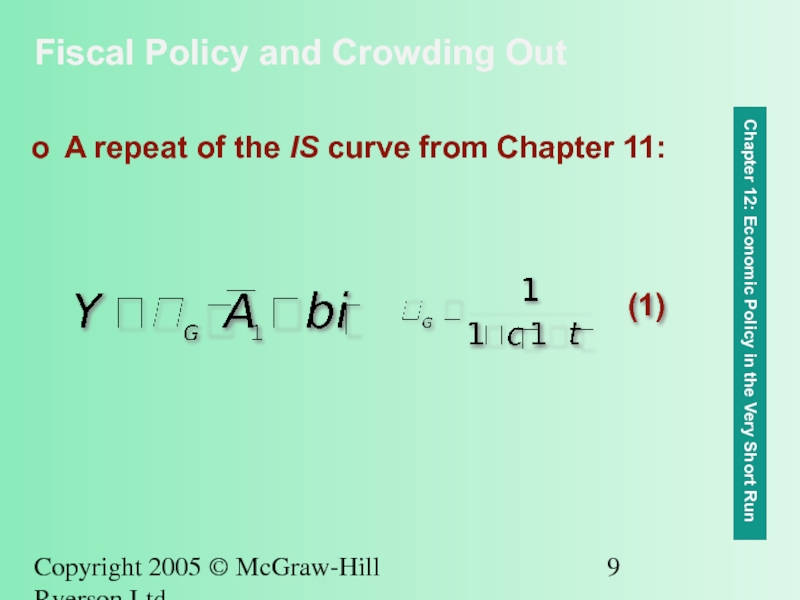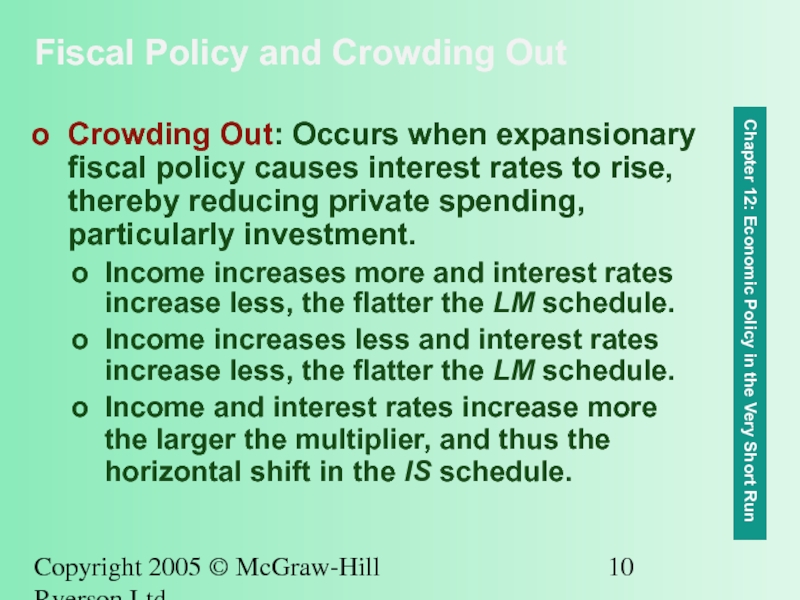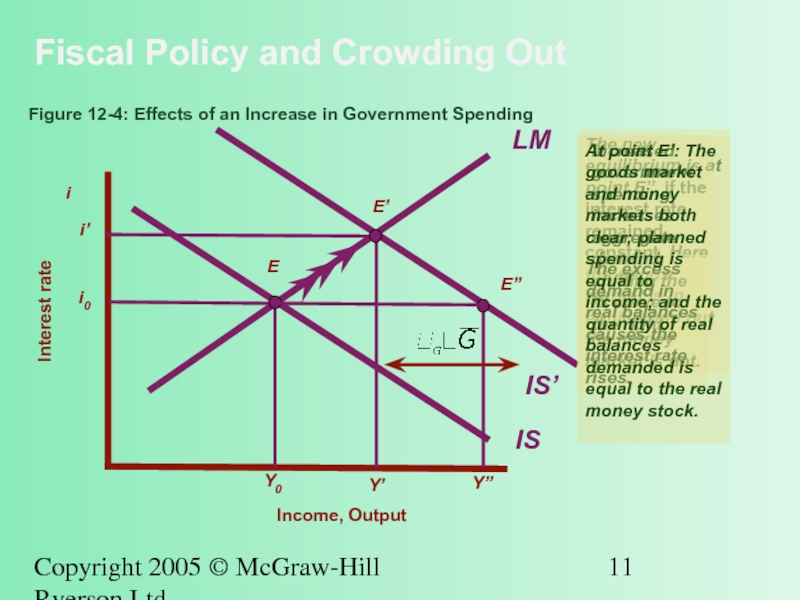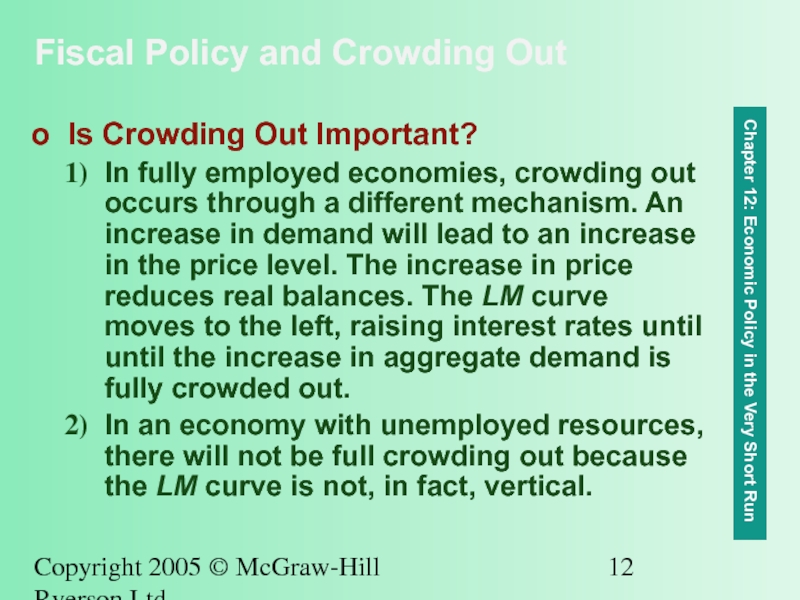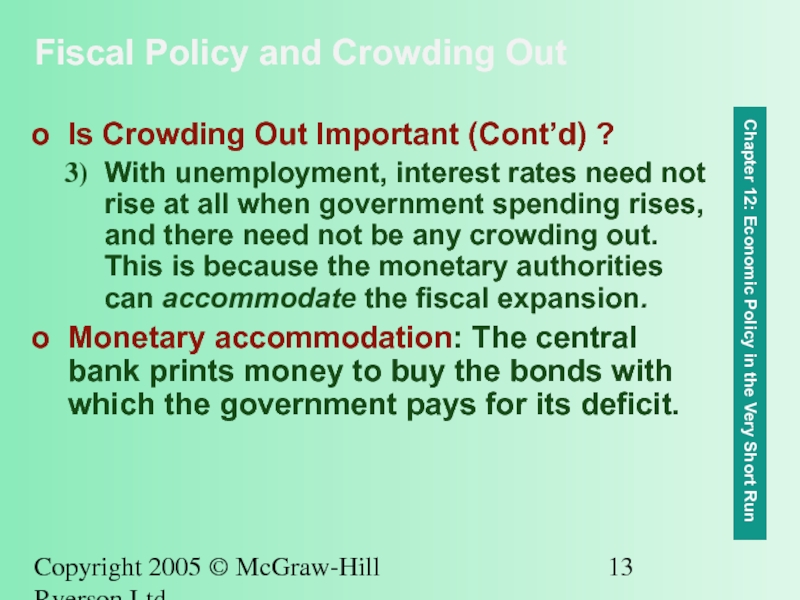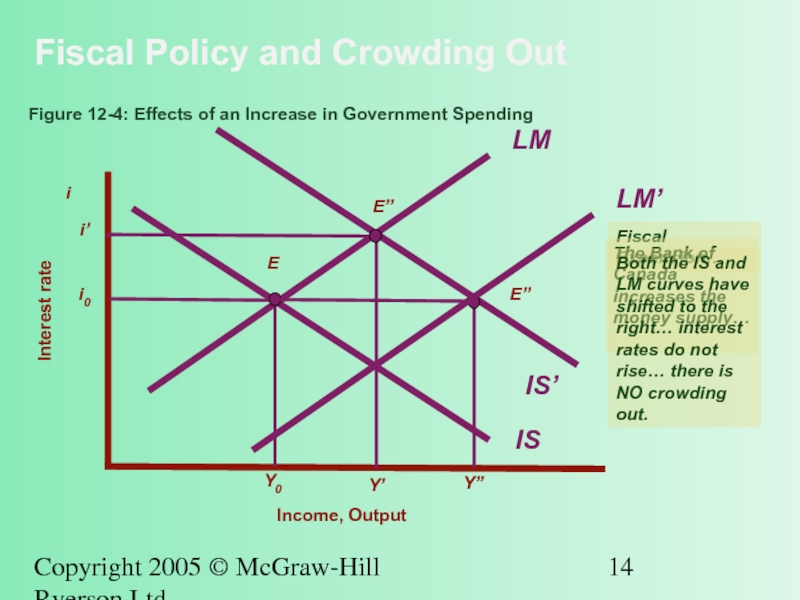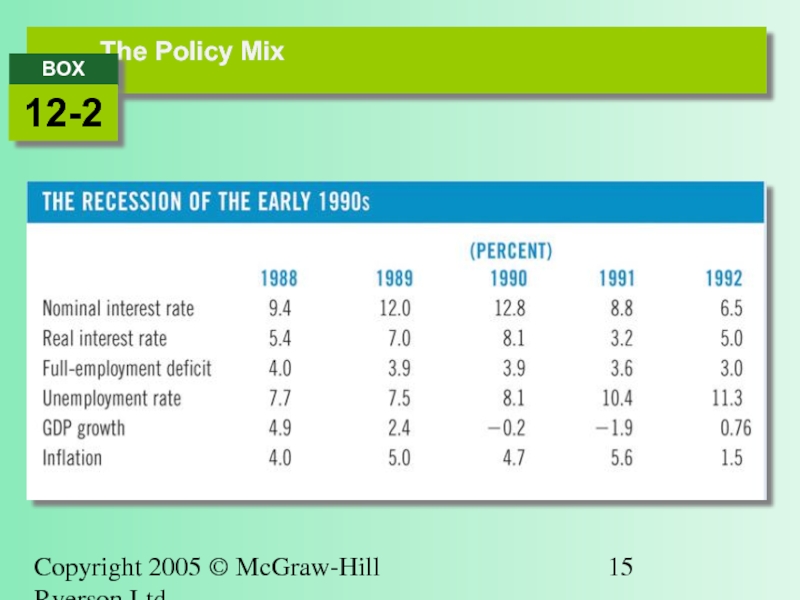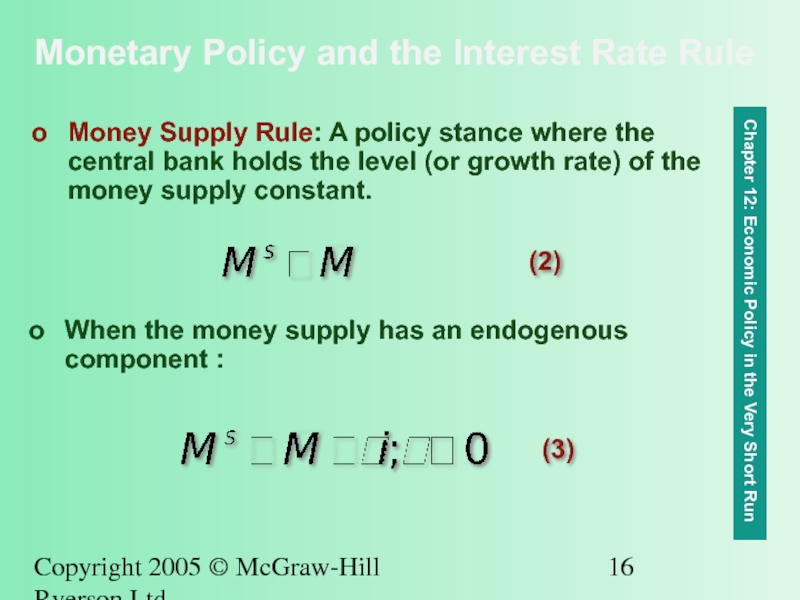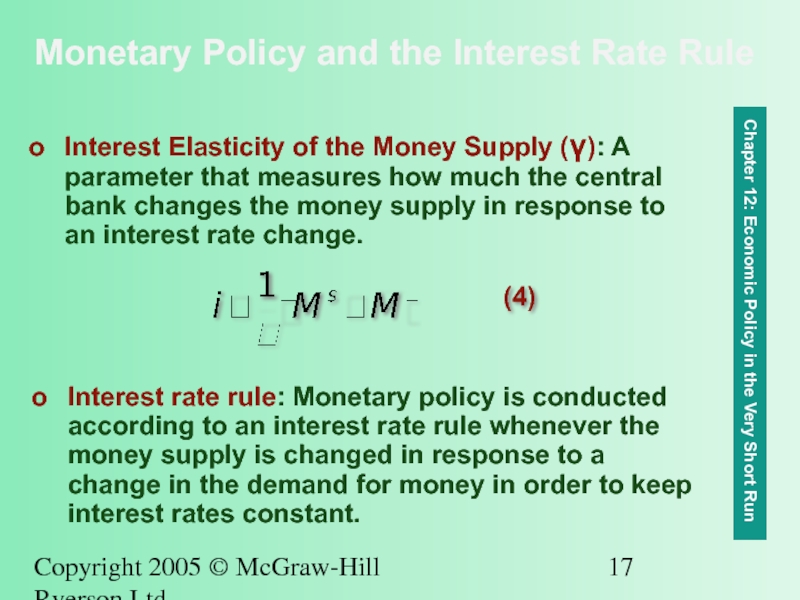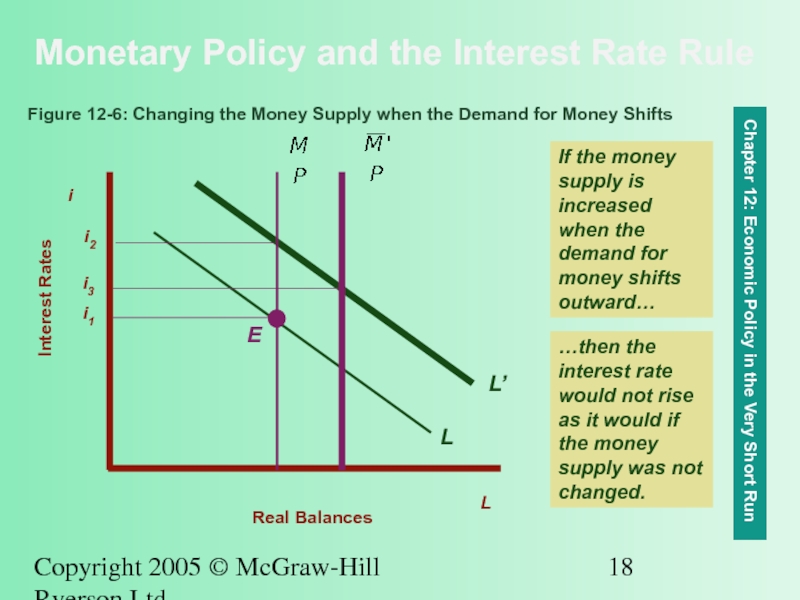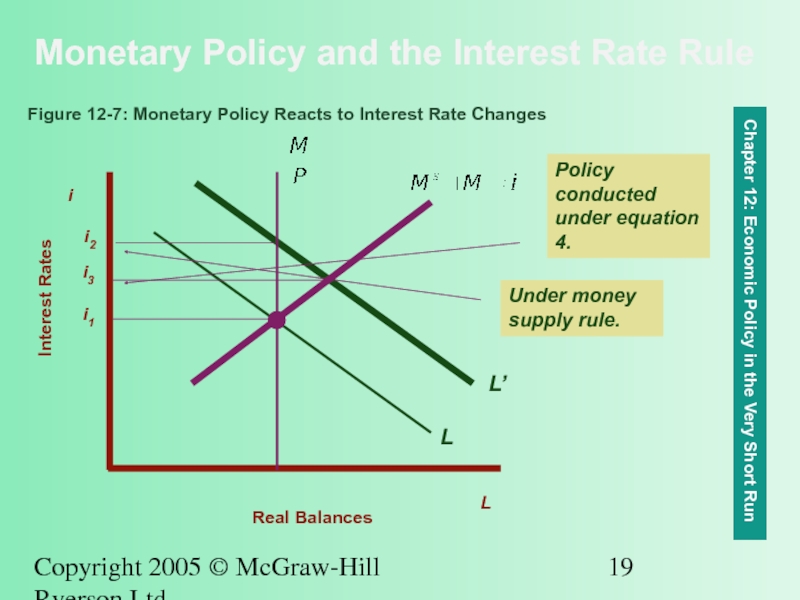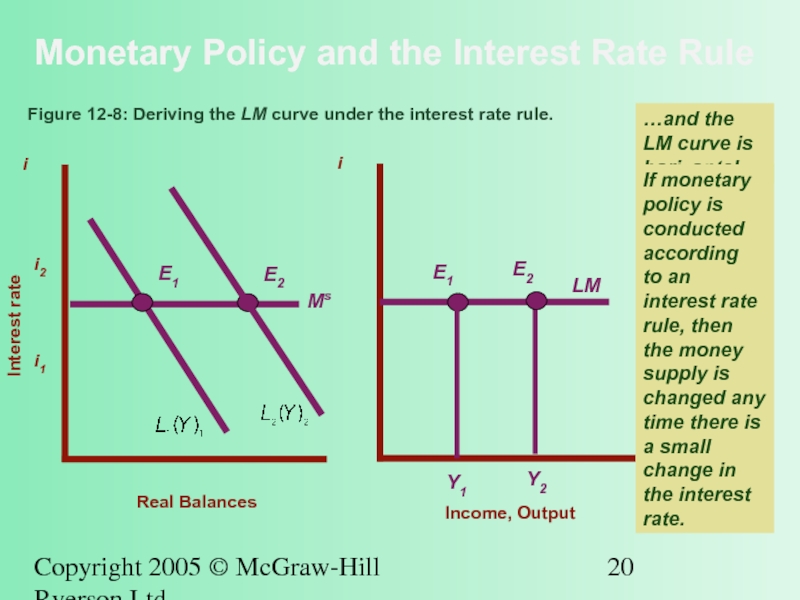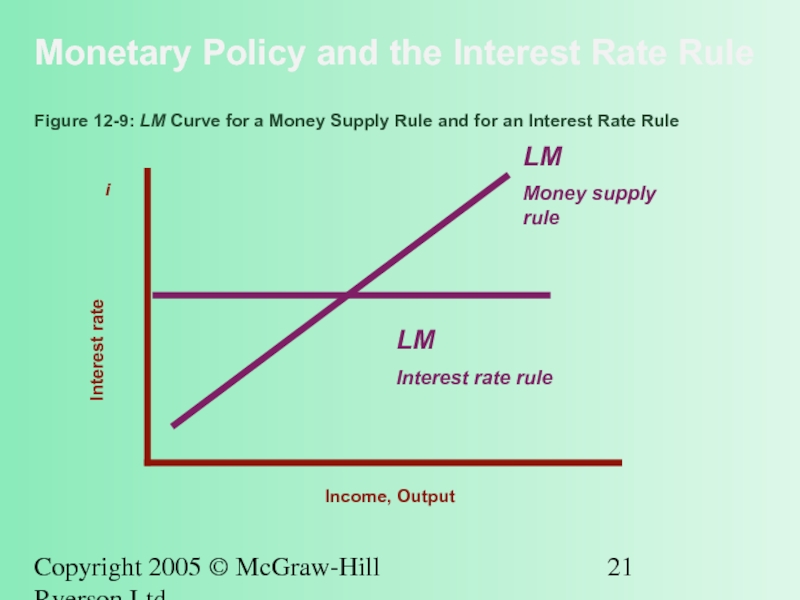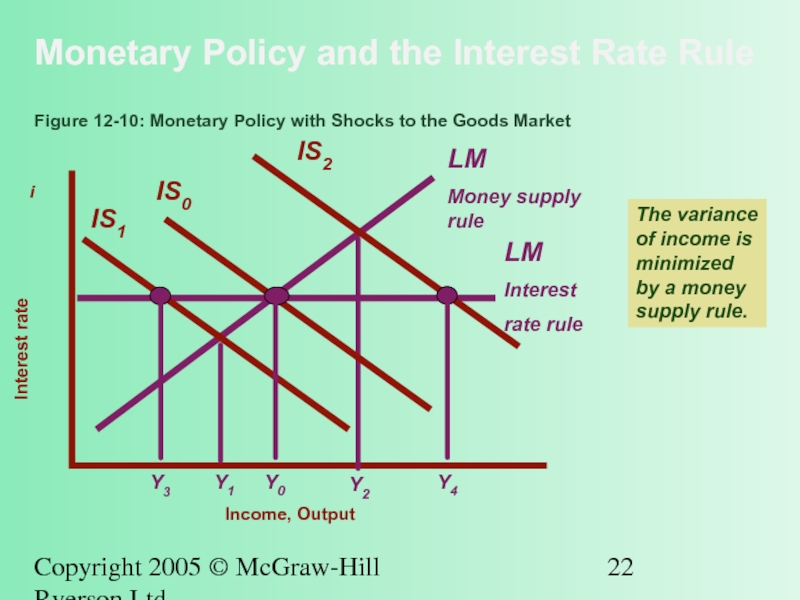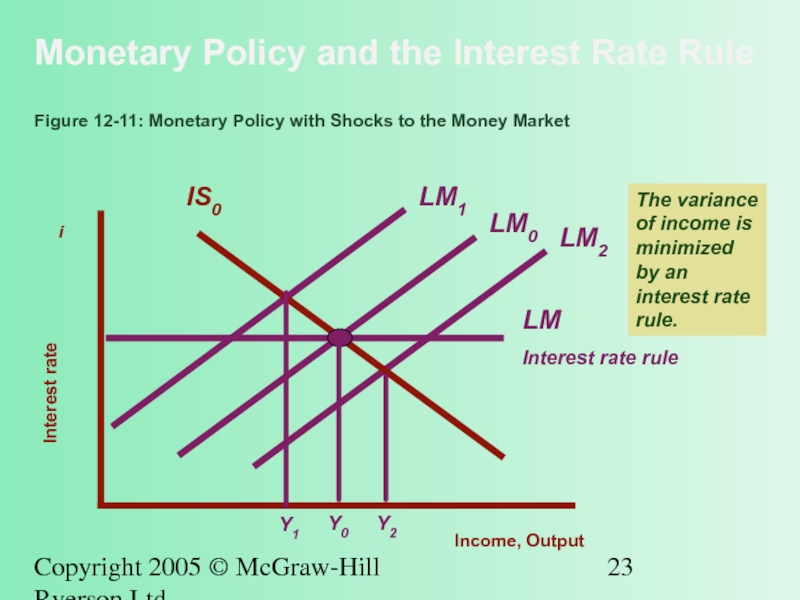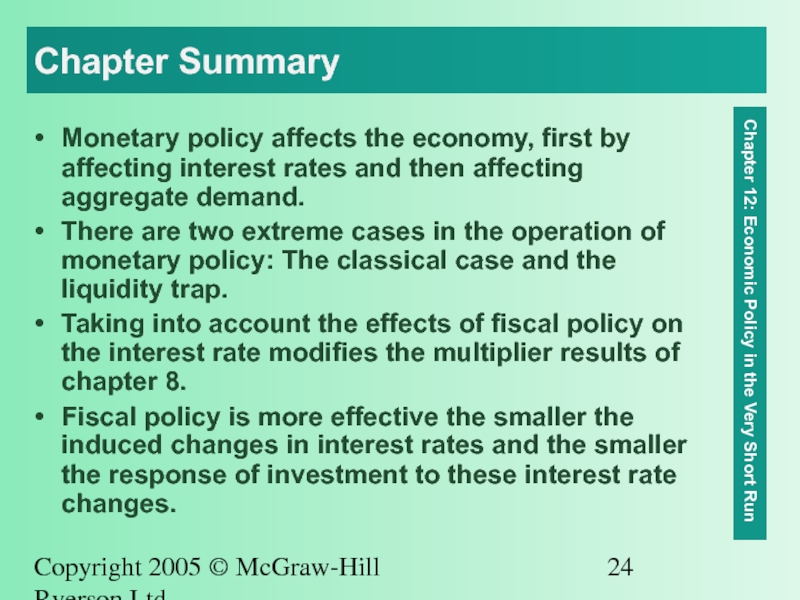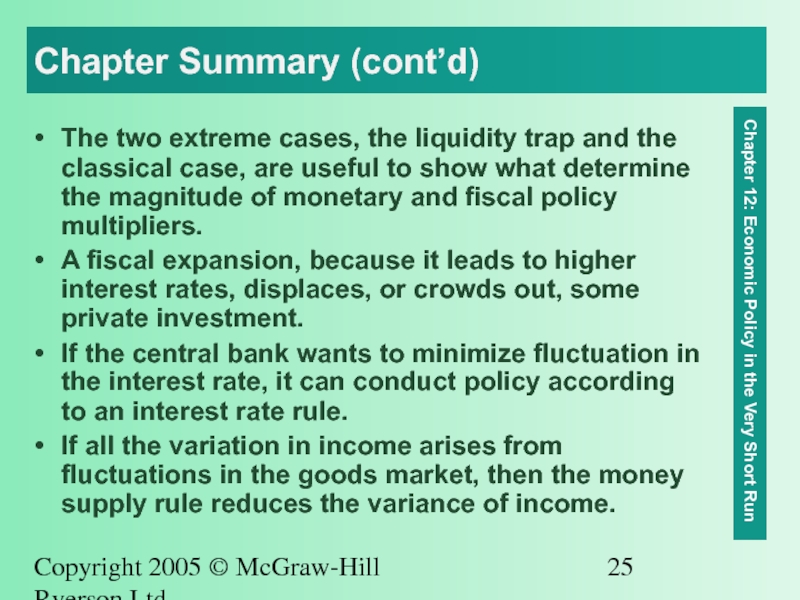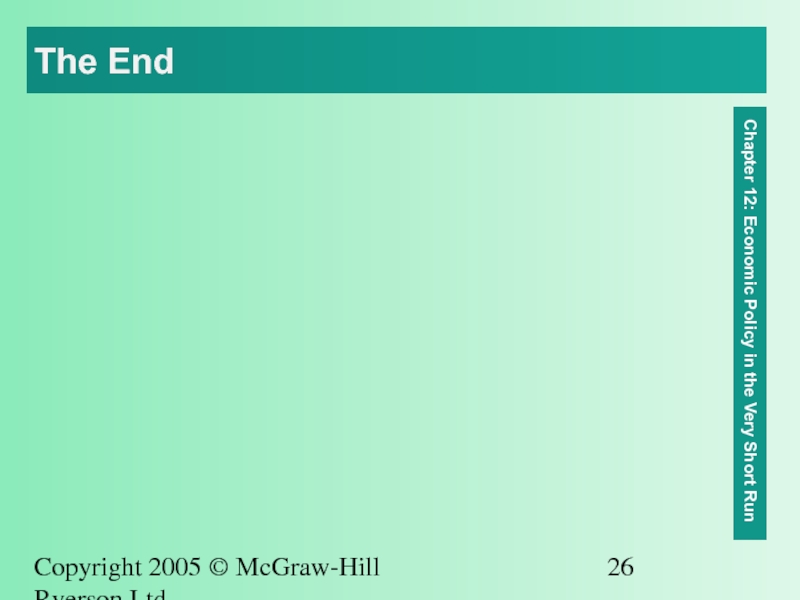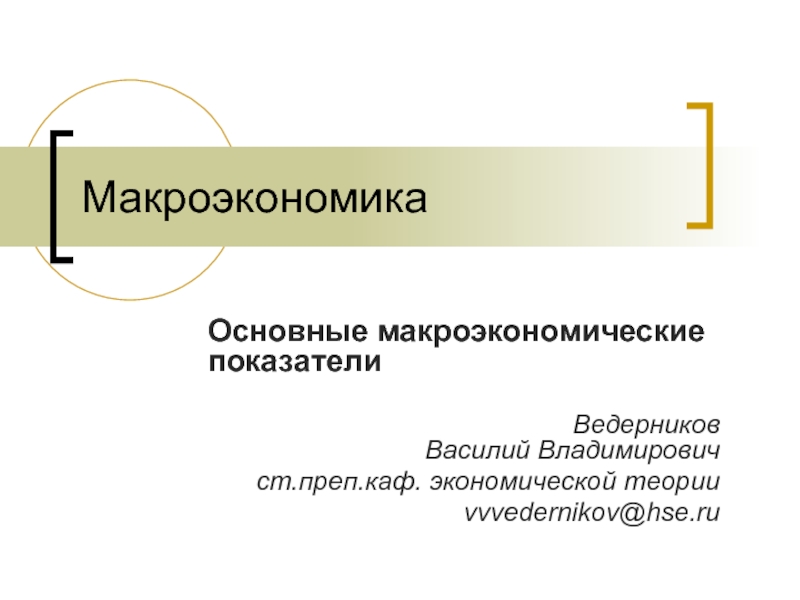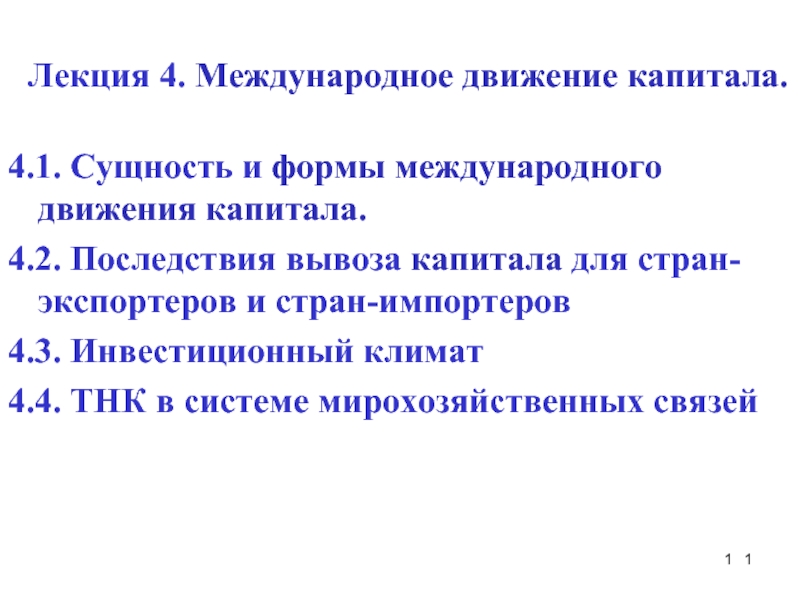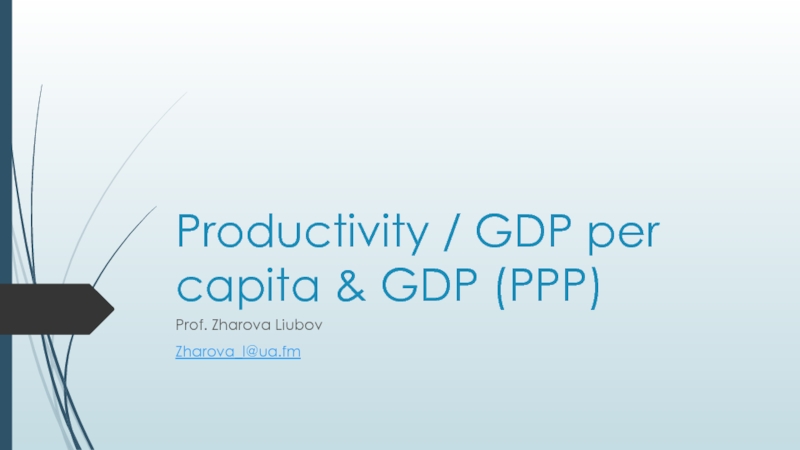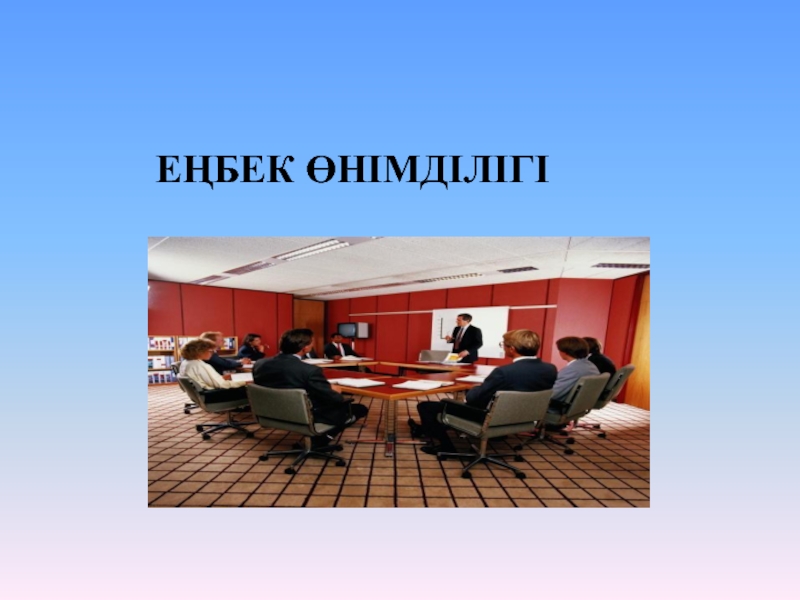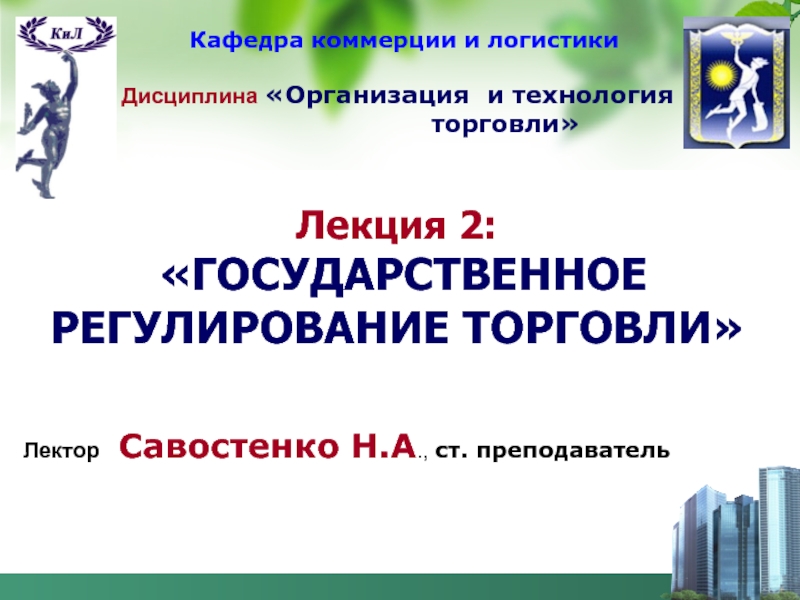- Главная
- Разное
- Дизайн
- Бизнес и предпринимательство
- Аналитика
- Образование
- Развлечения
- Красота и здоровье
- Финансы
- Государство
- Путешествия
- Спорт
- Недвижимость
- Армия
- Графика
- Культурология
- Еда и кулинария
- Лингвистика
- Английский язык
- Астрономия
- Алгебра
- Биология
- География
- Детские презентации
- Информатика
- История
- Литература
- Маркетинг
- Математика
- Медицина
- Менеджмент
- Музыка
- МХК
- Немецкий язык
- ОБЖ
- Обществознание
- Окружающий мир
- Педагогика
- Русский язык
- Технология
- Физика
- Философия
- Химия
- Шаблоны, картинки для презентаций
- Экология
- Экономика
- Юриспруденция
Monetary Policy and Fiscal Policy in the Very Short Run презентация
Содержание
- 1. Monetary Policy and Fiscal Policy in the Very Short Run
- 2. 12 Monetary Policy and Fiscal Policy in
- 3. Copyright 2005 © McGraw-Hill Ryerson Ltd.
- 4. Copyright 2005 © McGraw-Hill Ryerson Ltd.
- 5. Copyright 2005 © McGraw-Hill Ryerson Ltd.
- 6. Copyright 2005 © McGraw-Hill Ryerson Ltd.
- 7. Copyright 2005 © McGraw-Hill Ryerson Ltd.
- 8. Copyright 2005 © McGraw-Hill Ryerson Ltd.
- 9. Copyright 2005 © McGraw-Hill Ryerson Ltd. A classical IS-LM model
- 10. Copyright 2005 © McGraw-Hill Ryerson Ltd.
- 11. Copyright 2005 © McGraw-Hill Ryerson Ltd.
- 12. Copyright 2005 © McGraw-Hill Ryerson Ltd.
- 13. Copyright 2005 © McGraw-Hill Ryerson Ltd.
- 14. Copyright 2005 © McGraw-Hill Ryerson Ltd.
- 15. Copyright 2005 © McGraw-Hill Ryerson Ltd.
- 16. Copyright 2005 © McGraw-Hill Ryerson Ltd. The Policy Mix
- 17. Copyright 2005 © McGraw-Hill Ryerson Ltd.
- 18. Copyright 2005 © McGraw-Hill Ryerson Ltd.
- 19. Copyright 2005 © McGraw-Hill Ryerson Ltd.
- 20. Copyright 2005 © McGraw-Hill Ryerson Ltd.
- 21. Copyright 2005 © McGraw-Hill Ryerson Ltd.
- 22. Copyright 2005 © McGraw-Hill Ryerson Ltd.
- 23. Copyright 2005 © McGraw-Hill Ryerson Ltd.
- 24. Copyright 2005 © McGraw-Hill Ryerson Ltd.
- 25. Copyright 2005 © McGraw-Hill Ryerson Ltd.
- 26. Copyright 2005 © McGraw-Hill Ryerson Ltd.
- 27. Copyright 2005 © McGraw-Hill Ryerson Ltd.
Слайд 212
Monetary Policy and Fiscal Policy in the Very Short Run Learning
Understand that both fiscal and monetary policy can be used to stabilize the economy in the short run.
Understand that the output effect of expansionary fiscal policy is reduced by crowding out.
Understand that the slope of the LM curve has an important bearing on the effectiveness of fiscal and monetary policy.
PowerPoint® slides prepared by Marc Prud’Homme, University of Ottawa
Copyright 2005 © McGraw-Hill Ryerson Ltd.
Слайд 3Copyright 2005 © McGraw-Hill Ryerson Ltd.
The Very Short Run
Chapter
Figure 12-1: 90-Day Treasury Bill Rate and Real GDP Growth, Quarterly, 1997-2002
Слайд 4Copyright 2005 © McGraw-Hill Ryerson Ltd.
Monetary Policy
Monetary Policy: Any decision
The adjustment of the economy as a result of this monetary policy change is dependent on two general responses:
It must have the ability to lower interest rates.
Its ability to change real output in the very short run depends on the interest rate response in the IS curve.
Chapter 12: Economic Policy in the Very Short Run
Слайд 5Copyright 2005 © McGraw-Hill Ryerson Ltd.
Monetary Policy
Figure 12-2: Monetary Policy
Income,
The increase in the real money stock shifts the LM curve to the right.
Chapter 12: Economic Policy in the Very Short Run
Adjustment path 1: Initial response of the economy is to move to E1 where is interest rates are lower but output has not changed.
Adjustment path 2: The lower interest rates brings excess demand for goods, so output starts to increase.
Interest rate
Слайд 6Copyright 2005 © McGraw-Hill Ryerson Ltd.
Monetary Policy
Liquidity trap: A situation
The Economist: Is Japan in a Liquidity Trap?
Modern version of the liquidity trap: When interest rates are so low that a central bank has no scope to lower them further.
Chapter 12: Economic Policy in the Very Short Run
Слайд 7Copyright 2005 © McGraw-Hill Ryerson Ltd.
Policy in Action
The liquidity trap
September 11th
Lower interest rates initiated by the Bank of Canada and the US Federal Reserve Board.
40-year low.
Output growth remained sluggish US economy.
Output growth rebounded in Canada.
Слайд 8Copyright 2005 © McGraw-Hill Ryerson Ltd.
Since the money supply curve
The Goods Market and the IS Curve
Chapter 12: Economic Policy in the Very Short Run
Figure 12-3: The Money Market when h = 0
Interest rate
Real Balances
i
L
When the interest elasticity of money demand (h) is zero, the money demand curve is vertical.
Слайд 10Copyright 2005 © McGraw-Hill Ryerson Ltd.
Fiscal Policy and Crowding Out
A
Chapter 12: Economic Policy in the Very Short Run
Слайд 11Copyright 2005 © McGraw-Hill Ryerson Ltd.
Fiscal Policy and Crowding Out
Crowding Out: Occurs when expansionary fiscal policy causes interest rates to rise, thereby reducing private spending, particularly investment.
Income increases more and interest rates increase less, the flatter the LM schedule.
Income increases less and interest rates increase less, the flatter the LM schedule.
Income and interest rates increase more the larger the multiplier, and thus the horizontal shift in the IS schedule.
Слайд 12Copyright 2005 © McGraw-Hill Ryerson Ltd.
Fiscal Policy and Crowding Out
Figure
Interest rate
Income, Output
i
The new equilibrium is at point E’’, if the interest rate remained constant. Here the goods market is in equilibrium but the money market is not.
Increased government spending increases aggregate demand, shifting the IS curve to the right.
The excess demand in real balances causes the interest rate rises.
At point E’: The goods market and money markets both clear; planned spending is equal to income; and the quantity of real balances demanded is equal to the real money stock.
Слайд 13Copyright 2005 © McGraw-Hill Ryerson Ltd.
Fiscal Policy and Crowding Out
Is Crowding Out Important?
In fully employed economies, crowding out occurs through a different mechanism. An increase in demand will lead to an increase in the price level. The increase in price reduces real balances. The LM curve moves to the left, raising interest rates until until the increase in aggregate demand is fully crowded out.
In an economy with unemployed resources, there will not be full crowding out because the LM curve is not, in fact, vertical.
Слайд 14Copyright 2005 © McGraw-Hill Ryerson Ltd.
Fiscal Policy and Crowding Out
Is Crowding Out Important (Cont’d) ?
With unemployment, interest rates need not rise at all when government spending rises, and there need not be any crowding out. This is because the monetary authorities can accommodate the fiscal expansion.
Monetary accommodation: The central bank prints money to buy the bonds with which the government pays for its deficit.
Слайд 15Copyright 2005 © McGraw-Hill Ryerson Ltd.
Fiscal Policy and Crowding Out
Figure
Interest rate
Income, Output
i
Fiscal Expansion…
The Bank of Canada increases the money supply…
Both the IS and LM curves have shifted to the right… interest rates do not rise… there is NO crowding out.
Слайд 17Copyright 2005 © McGraw-Hill Ryerson Ltd.
Monetary Policy and the Interest
Chapter 12: Economic Policy in the Very Short Run
Money Supply Rule: A policy stance where the central bank holds the level (or growth rate) of the money supply constant.
When the money supply has an endogenous component :
Слайд 18Copyright 2005 © McGraw-Hill Ryerson Ltd.
Monetary Policy and the Interest
Chapter 12: Economic Policy in the Very Short Run
Interest Elasticity of the Money Supply (γ): A parameter that measures how much the central bank changes the money supply in response to an interest rate change.
Interest rate rule: Monetary policy is conducted according to an interest rate rule whenever the money supply is changed in response to a change in the demand for money in order to keep interest rates constant.
Слайд 19Copyright 2005 © McGraw-Hill Ryerson Ltd.
Monetary Policy and the Interest
Chapter 12: Economic Policy in the Very Short Run
If the money supply is increased when the demand for money shifts outward…
Figure 12-6: Changing the Money Supply when the Demand for Money Shifts
…then the interest rate would not rise as it would if the money supply was not changed.
Слайд 20Copyright 2005 © McGraw-Hill Ryerson Ltd.
Monetary Policy and the Interest
Chapter 12: Economic Policy in the Very Short Run
Figure 12-7: Monetary Policy Reacts to Interest Rate Changes
Слайд 21Copyright 2005 © McGraw-Hill Ryerson Ltd.
Monetary Policy and the Interest
Figure 12-8: Deriving the LM curve under the interest rate rule.
Interest rate
Real Balances
i
Income, Output
i
i1
…and the LM curve is horizontal.
If monetary policy is conducted according to an interest rate rule, then the money supply is changed any time there is a small change in the interest rate.
i2
Слайд 22Copyright 2005 © McGraw-Hill Ryerson Ltd.
Monetary Policy and the Interest
Figure 12-9: LM Curve for a Money Supply Rule and for an Interest Rate Rule
Interest rate
Income, Output
i
Слайд 23Copyright 2005 © McGraw-Hill Ryerson Ltd.
Monetary Policy and the Interest
Figure 12-10: Monetary Policy with Shocks to the Goods Market
Interest rate
Income, Output
i
The variance of income is minimized by a money supply rule.
Слайд 24Copyright 2005 © McGraw-Hill Ryerson Ltd.
Monetary Policy and the Interest
Figure 12-11: Monetary Policy with Shocks to the Money Market
Interest rate
Income, Output
i
The variance of income is minimized by an interest rate rule.
Слайд 25Copyright 2005 © McGraw-Hill Ryerson Ltd.
Chapter Summary
Monetary policy affects the
There are two extreme cases in the operation of monetary policy: The classical case and the liquidity trap.
Taking into account the effects of fiscal policy on the interest rate modifies the multiplier results of chapter 8.
Fiscal policy is more effective the smaller the induced changes in interest rates and the smaller the response of investment to these interest rate changes.
Chapter 12: Economic Policy in the Very Short Run
Слайд 26Copyright 2005 © McGraw-Hill Ryerson Ltd.
Chapter Summary (cont’d)
The two extreme
A fiscal expansion, because it leads to higher interest rates, displaces, or crowds out, some private investment.
If the central bank wants to minimize fluctuation in the interest rate, it can conduct policy according to an interest rate rule.
If all the variation in income arises from fluctuations in the goods market, then the money supply rule reduces the variance of income.
Chapter 12: Economic Policy in the Very Short Run
